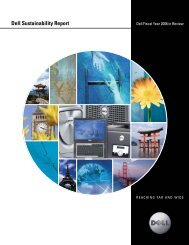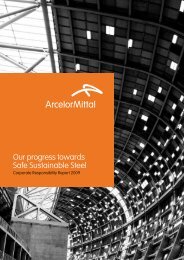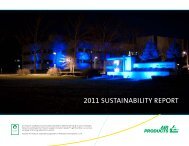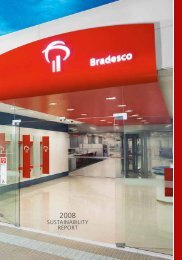English - The Clorox Company
English - The Clorox Company
English - The Clorox Company
You also want an ePaper? Increase the reach of your titles
YUMPU automatically turns print PDFs into web optimized ePapers that Google loves.
PLANET<br />
“Dumpster Dives” Help to Reduce<br />
Landfill Waste<br />
Cost savings initiatives and manufacturing<br />
excellence programs have helped <strong>Clorox</strong> build<br />
a solid record in the areas of reducing and reusing<br />
materials, but recent audits have found that we still<br />
send too much waste to landfills. “dumpster dives,”<br />
where employee volunteers literally dump and sort<br />
through trash, have been an<br />
effective initiative to raise<br />
awareness of what can be<br />
recycled and to encourage<br />
changes about what gets<br />
deposited in the trash.<br />
Dives at our Tampa, Fla.,<br />
and Amherst, Va., plants<br />
have led to reductions of<br />
waste sent to landfills of<br />
more than 50 percent.<br />
<strong>The</strong>se achievements are<br />
helping us make progress<br />
toward our commitment<br />
to reduce company-wide<br />
solid waste by 20 percent<br />
(per case of product sold)<br />
from 2007 through 2013.<br />
Solid Waste<br />
13,893<br />
12,590<br />
12,783<br />
31.7<br />
28.4 28.9<br />
2007 2008 2009<br />
TONS<br />
RATIO (tons of waste<br />
per million cases)<br />
<strong>The</strong> vast majority of the solid waste that <strong>Clorox</strong><br />
produces is nonhazardous in nature and we employ<br />
manufacturing practices that minimize such waste.<br />
<strong>The</strong> small amount of hazardous waste that we do<br />
produce is properly handled by approved vendors<br />
and properly tracked through its disposal process.<br />
Biodiversity and Habitat Conservation<br />
<strong>The</strong> preservation and protection of biodiversity and<br />
natural ecosystems go hand in hand with resource<br />
conservation. To this end, <strong>Clorox</strong> complies with<br />
global, federal, state and local biodiversity legislation<br />
and regulations and, whenever possible, goes beyond<br />
legal requirements to ensure that our manufacturing<br />
operations do not negatively impact biodiversity,<br />
natural habitats, wetlands, forest lands, fisheries or<br />
local plant and animal species.<br />
Our overall operational impact on biodiversity is<br />
insignificant, given the location and nature of our<br />
operations as well as the products we manufacture.<br />
<strong>The</strong> one exception is our plant in Aberdeen, Md.,<br />
which manufactures bleach products. It is located on<br />
150 acres of wetlands owned by <strong>Clorox</strong> that we are<br />
committed to protecting. In 1993, our Aberdeen plant,<br />
which resides on eight of these acres, was one of only<br />
three buildings worldwide to receive the Distinguished<br />
Environmental Planning Award from the Industrial<br />
Development Resource Council. We were selected based<br />
on our attention to energy conservation and preservation<br />
of this 150-acre wetlands area.<br />
<strong>Clorox</strong>’s “dumpster dives” help divert<br />
waste from landfills.<br />
46 <strong>The</strong> <strong>Clorox</strong> <strong>Company</strong> | 2010 CRR

















